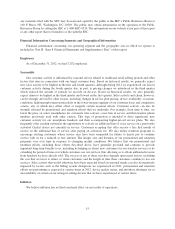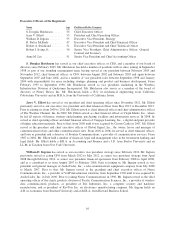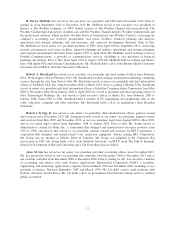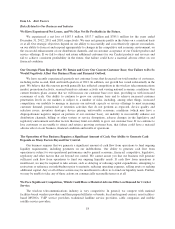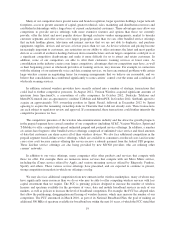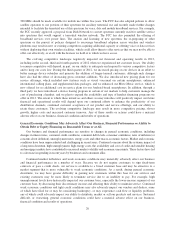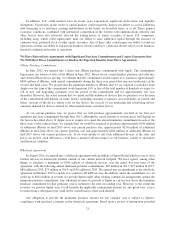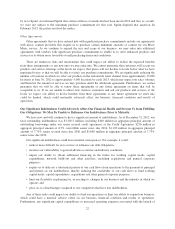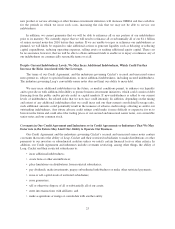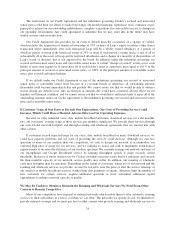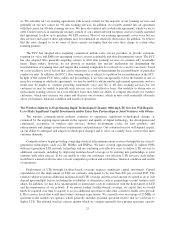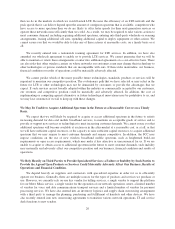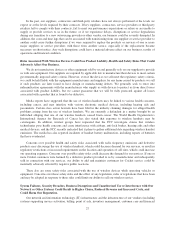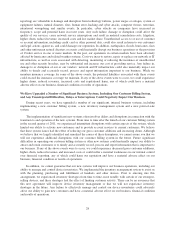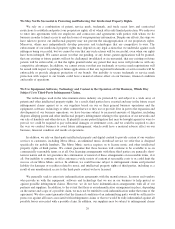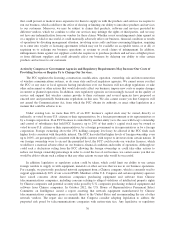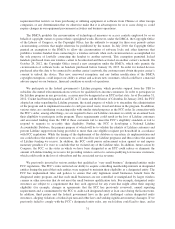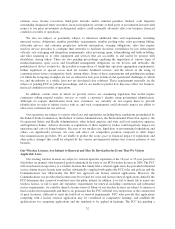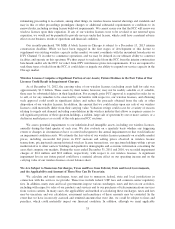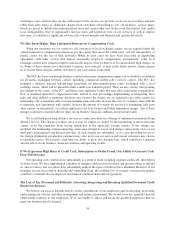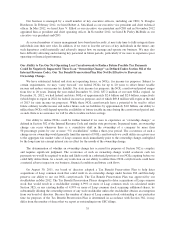Cricket Wireless 2012 Annual Report Download - page 39
Download and view the complete annual report
Please find page 39 of the 2012 Cricket Wireless annual report below. You can navigate through the pages in the report by either clicking on the pages listed below, or by using the keyword search tool below to find specific information within the annual report.us. We currently rely on roaming agreements with several carriers for the majority of our roaming services and
generally on one key carrier for 3G data roaming services. In addition, we recently entered into an agreement
with that carrier for 4G data roaming services. We have also entered into a wholesale agreement, which we use to
offer Cricket services in nationwide retailers outside of our current network footprint, and we recently amended
that agreement to allow us to purchase 4G LTE services. Most of our roaming agreements cover voice but not
data services and some of these agreements may be terminated on relatively short notice. In addition, we believe
that the rates charged to us by some of these carriers are higher than the rates they charge to certain other
roaming partners.
The FCC has adopted rules requiring commercial mobile radio service providers to provide automatic
roaming for voice and SMS text messaging services on just, reasonable and non-discriminatory terms. The FCC
has also adopted rules generally requiring carriers to offer data roaming services on commercially reasonable
terms. These orders, however, do not provide or mandate any specific mechanism for determining the
reasonableness of roaming rates and require that roaming complaints be resolved on a case-by-case basis, based
on a non-exclusive list of factors that can be taken into account in determining the reasonableness of particular
conduct or rates. In addition, the FCC’s data roaming order is subject to a petition for reconsideration at the FCC.
In light of the current FCC rules, orders and proceedings, if we were unexpectedly to lose the benefit of one or
more key roaming or wholesale agreements, we may be unable to obtain similar replacement agreements and as a
result may be unable to continue providing nationwide voice and 3G or 4G data roaming services for our
customers or may be unable to provide such services on a cost-effective basis. Our inability to obtain new or
replacement roaming services on a cost-effective basis may limit our ability to compete effectively for wireless
customers, which may increase our churn and decrease our revenues, which in turn could materially adversely
affect our business, financial condition and results of operations.
The Wireless Industry Is Experiencing Rapid Technological Change; Offering LTE Services Will Require
Us to Make Significant Capital Investments and/or Enter Into Partnerships or Joint Ventures with Others.
The wireless communications industry continues to experience significant technological change, as
evidenced by the ongoing improvements in the capacity and quality of digital technology, the development and
commercial acceptance of wireless data services, shorter development cycles for new products, and
enhancements and changes in end-user requirements and preferences. Our continued success will depend, in part,
on our ability to anticipate and adapt to technological changes and to offer, on a timely basis, services that meet
customer demands.
Competitors have begun providing competing wireless telecommunications services through the use of next-
generation technologies, such as LTE, WiMax and HSPA+. We have covered approximately 21 million POPs
with next-generation LTE network technology and are exploring cost-effective ways to deliver LTE services to
additional customers, including by deploying facilities-based coverage or by entering into partnerships or joint
ventures with other carriers. If we are unable to offer our customers cost-effective LTE services, such failure
would have a material adverse effect on our competitive position and our business, financial condition and results
of operations.
Deployment of LTE through facilities-based coverage requires significant capital investment. Capital
expenditures for the deployment of LTE are currently anticipated to be less than $10 per covered POP. The
extent to which we pursue additional facilities-based LTE coverage and the actual amount we spend to do so will
depend upon multiple factors, including the availability of alternatives such as partnerships or joint ventures with
others. In addition, we may have unanticipated or unforeseen costs in connection with the deployment of LTE
and the maintenance of our network. If we pursue further facilities-based coverage, we expect that we would
likely be required over time to acquire or access additional spectrum or take other actions to enable us to provide
LTE at service levels that would meet future customer expectations. We currently own an average of 23 MHz of
spectrum in the markets we operate, which generally includes an initial spectrum reserve that we could use to
deploy LTE. The national wireless carriers against which we compete generally have greater spectrum capacity
25


